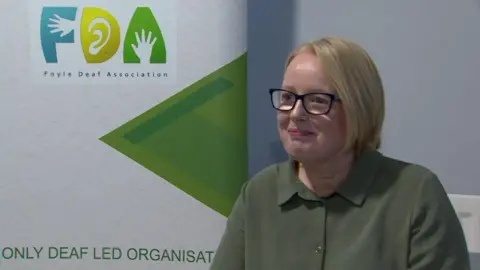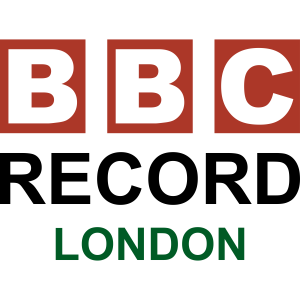Maria McCann,North east reporter and
Auryn Cox,BBC News NI
 BBC
BBCA health trust has apologised to a deaf couple after hospital staff did not know what a British Sign Language (BSL) interpreter was.
Colleen Agnew’s husband was taken to hospital recently after an episode in which he was struggling to breathe, due to underlying health issues, at their home in Kilrea, County Londonderry.
Her son notified Causeway Hospital of their communication needs ahead of their arrival, but they were met with confusion upon arrival, Mrs Agnew said.
Apologising for the “distress caused”, the Northern Trust said information on booking BSL interpreters is regularly provided to staff and a reminder would be issued as a result of this incident.
The trust also said lanyards have been introduced which patients can wear to indicate they may need additional communication support.
The NHS has a legal responsibility to ensure its services are accessible to everyone, including the provision of interpreters.
‘No idea about deafness’
Mrs Agnew’s first language is BSL.
Upon arrival at hospital, she typed her request for an interpreter on her phone.
But the receptionist asked, ‘What is a BSL interpreter?’, Mrs Agnew said.
“They had no idea about deafness. They had no real incentive to try and sort out this problem. They just sort of froze.”
Mrs Agnew said she noted posters in reception about multiple language interpreters but none for BSL.
Not having access to an interpreter led to the couple being left, “worried”, for two hours at the hospital, their daughter, Susannah Agnew, said.
Mrs Agnew eventually obtained an interpreter, using her own contacts.
“I felt really rushed and panicked… my main priority was to make sure my husband was OK,” she said.
“All my anxieties disappeared whenever I finally got an interpreter into the hospital. It means that I could finally communicate, I could finally understand what was going on.”
How many people use BSL?
People who are born profoundly deaf, meaning they have little or no hearing, often rely on sign language rather than speech to communicate.
A BSL interpreter helps translate sign language into spoken language and vice versa.
Estimates for the number of BSL and Irish Sign Language (ISL) users in Northern Ireland vary widely.
A 2020 Stormont study said there may be as many as 18,000 people who use BSL or ISL.
While the Department of Health says approximately 8,000 people in Northern Ireland use either type of sign language.
Communication barriers
The couple’s children often have to help their parents, in terms of communication and phone calls.
Their daughter told BBC News NI that the communication barriers deaf people face are unfair.
Even before they attended hospital, Mrs Agnew said they experienced issues trying to contact the emergency services via a specialist app, set up in 2022.
The 999 BSL app, which connects users with an interpreter to relay emergency calls, repeatedly cut out when she tried to use it, she said.
However, an Ofcom report published this year found “at least two lives are saved per year due to the service”.
Matthew King, general manager at Sign Language Interactions, said they take any report of service disruption very seriously and are investigating the incident.
Deaf people can also contact emergency services by using Relay UK, a broader service that includes a text-based emergency option called Emergency SMS which users can register for by texting “register” to 999.
The family are calling for more hospital staff training, clearer protocols for booking interpreters and basic sign language awareness across healthcare settings.
They also believe sign language should be taught in schools.

Seana Taylor, from the Foyle Deaf Association, is also a child of deaf adults (CODA).
She said every CODA is likely to have a story similar to the Agnews.
When Ms Taylor’s mother needed surgery recently, she said it was easier to book an interpreter herself than to try and go through the hospital.
However, she said there is a lot of good work ongoing to address issues in healthcare settings.
“It’s just about people,” she said.
“The people that are delivering the service, does everybody understand the processes, is there any further training that needs to be done?”




